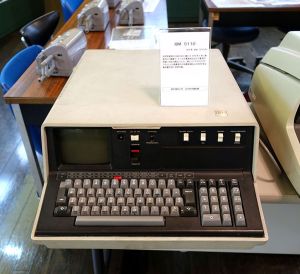APL\360: Difference between revisions
(→Primitives: Use 1968 contributed program version) |
(Undo revision 3213 by Adám Brudzewsky (talk): Use a language's own terminology on its page) Tag: Undo |
||
| Line 2: | Line 2: | ||
| array model = [[flat array model|flat]] without [[box|boxes]] | | array model = [[flat array model|flat]] without [[box|boxes]] | ||
| index origin = <source lang=apl inline>)ORIGIN</source> 0 or 1 (later <source lang=apl inline>⎕IO</source>) | | index origin = <source lang=apl inline>)ORIGIN</source> 0 or 1 (later <source lang=apl inline>⎕IO</source>) | ||
| function styles = [[ | | function styles = [[defined function]] | ||
| numeric types = floats (64-bit [[wikipedia:IBM_hexadecimal_floating_point|HFP]]) | | numeric types = floats (64-bit [[wikipedia:IBM_hexadecimal_floating_point|HFP]]) | ||
| unicode support = no | | unicode support = no | ||
Revision as of 15:35, 15 April 2020
APL\360 was the first implementation of APL using recognizable APL symbols. It ran on the IBM System/360, and was completed in November 1966 though at that time remained in use only within IBM. In 1973 its implementers, Larry Breed, Dick Lathwell and Roger Moore, were awarded the Grace Murray Hopper Award from the Association for Computing Machinery (ACM). It was given "for their work in the design and implementation of APL\360, setting new standards in simplicity, efficiency, reliability and response time for interactive systems."
Beginning in 1975, the IBM 5100 line of microcomputers offered APL\360 as one of two built-in ROM-based interpreted languages for the computer, complete with a keyboard and display that supported all the special symbols used in the language.
Significant developments to APL\360 included CMS/APL, which made use of the virtual storage capabilities of CMS, and APL.SV, which introduced shared variables, system variables and system functions. It was subsequently ported to the IBM System/370 and VSPC platforms until its final release in 1983, after which it was replaced by APL2.
Implementation
Internal types
APL\360 uses four element types for arrays, three numeric and one character:
- 1-bit packed Boolean
- 4-byte integer
- 8-byte floating point
- 1-byte character
Primitives
APL\360 evolved rapidly during its early development within IBM and more slowly as it became available to outside users. Here we show the primitives described in its documentation in 1968 when it was first released as a stand-alone product (a Type-III Library). Later additions include Matrix Inverse and Matrix Divide; Execute, Format, and Scan introduced by APL.SV; and an axis and Laminate form for the Catenate function.
Functions
| Glyph | Monadic | Dyadic |
|---|---|---|
+ |
Conjugate | Plus |
- |
Negative | Minus |
× |
Signum | Times |
÷ |
Reciprocal | Divide |
⌈ |
Ceiling | Maximum |
⌊ |
Floor | Minimum |
* |
Exponential | Power |
⍟ |
Natural logarithm | Logarithm |
| |
Magnitude | Residue |
? |
Roll | Deal |
○ |
Pi times | Circular |
! |
Factorial | Binomial coefficient |
~ |
Not | |
∧ |
And | |
∨ |
Or | |
⍲ |
Nand | |
⍱ |
Nor | |
< |
Less | |
≤ |
Not greater | |
= |
Equal | |
≥ |
Not less | |
> |
Greater | |
≠ |
Not equal | |
⍴ |
Size | Reshape |
, |
Ravel | Catenate |
[] |
Indexing | |
⍳ |
Index generator | Index of |
↑ |
Take | |
↓ |
Drop | |
⍋ |
Grade up (allows axis) | |
⍒ |
Grade down (allows axis) | |
/ |
Compress (allows axis) | |
⌿ |
||
\ |
Expand (allows axis) | |
⍀ |
||
⌽ |
Reverse (allows axis) |
Rotate (allows axis) |
⊖
| ||
⍉ |
Transpose | |
∊ |
Membership | |
⊥ |
Decode | |
⊤ |
Encode | |
Operators
|
| Glyph | Valence | Monadic call | Dyadic call |
|---|---|---|---|
/ |
Monadic | Reduction (allows axis) |
|
⌿ |
Monadic | ||
. |
Dyadic | Inner product | |
∘. |
Monadic | Outer product | |
[] |
Monadic | Axis | |
External links
- Bitsavers: APL
- Norbert Kehrer: IBM 5110 Emulator
- Bitsavers: IBM 5110
| APL dialects [edit] | |
|---|---|
| Maintained | APL+Win ∙ APL2 ∙ APL64 ∙ APL\iv ∙ Aplette ∙ April ∙ Co-dfns ∙ Dyalog APL ∙ Dyalog APL Vision ∙ dzaima/APL ∙ GNU APL ∙ Kap ∙ NARS2000 ∙ Pometo ∙ TinyAPL |
| Historical | A Programming Language ∙ A+ (A) ∙ APL# ∙ APL2C ∙ APL\360 ∙ APL/700 ∙ APL\1130 ∙ APL\3000 ∙ APL.68000 ∙ APL*PLUS ∙ APL.jl ∙ APL.SV ∙ APLX ∙ Extended Dyalog APL ∙ Iverson notation ∙ IVSYS/7090 ∙ NARS ∙ ngn/apl ∙ openAPL ∙ Operators and Functions ∙ PAT ∙ Rowan ∙ SAX ∙ SHARP APL ∙ Rationalized APL ∙ VisualAPL (APLNext) ∙ VS APL ∙ York APL |
| Derivatives | AHPL ∙ BQN ∙ CoSy ∙ ELI ∙ Glee ∙ I ∙ Ivy ∙ J ∙ Jelly ∙ K (Goal, Klong, Q) ∙ KamilaLisp ∙ Lang5 ∙ Lil ∙ Nial ∙ RAD ∙ Uiua |
| Overviews | Comparison of APL dialects ∙ Timeline of array languages ∙ Timeline of influential array languages ∙ Family tree of array languages |
